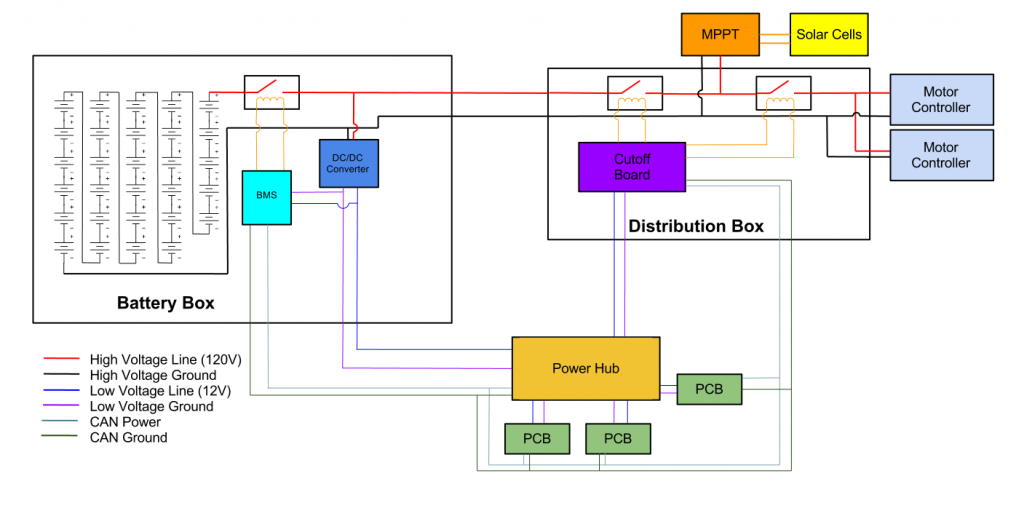Over the past winter break and semester, the CalSol Electrical Team has set its foundation towards an improved and more reliable Electrical System on Zephyr.
Through the Fall 2012 semester, the Electrical Team has recruited a number of new members. To prepare these members ready for real Solar Car design, we have conducted a series of training sessions ranging from basic electronics, soldering to microcontroller programming and circuit design.
At the same time, the Electrical Team was also discussing about the improvements we are going to make from Impulse’s electrical design. Deficiencies such as the lack of efficiency in the traditional passive balancing technology and the frequently happening connector problem would be eradicated when Zephyr is built.
By now, we have decided on a lot of stuff that would make Zephyr a more robust solar car, here is a list of major decisions made:
1. Explore the possibility of self-encapsulated solar cells.
As you may know from Min Ju’s blog post, the electrical team is exploring the possibility of encapsulating solar cells by ourselves. This might give us an edge on both cost and efficiency.
2. Active Battery Balancing Technologies
It is essential to make sure the modular voltages is the same in a multi-module battery pack if one wants to maximize the pack’s efficiency. Traditional passive balancing technology uses resistors to burn excess charge from modules with higher voltage to even out the difference, which is energetically inefficient and creates lots of heat. However, alternative technology such as capacitor based active balancing technology could actively transfer the excess charge from module with higher voltage to modules with lower voltage. Although such operation itself also consumes energy, considering the huge battery pack (400+ cells, 29 modules) we have for Zephyr, the net gain in efficiency is positive.
We have tried chips from different companies that are able to achieve this and development board has been made to test out these possibilities, which will be manufactured in a month.
3. Brand New Power Distribution System
Since Zephyr would be built with two rear drive motors, the power distribution system has to be different from Impulse’s. We have reviewed the power distribution system on Impulse and decided to have a completely new design for Zephyr.

As shown by the above diagram (Credit to Allan Wang, Power Lead), the new system would have a special Distribution Box that splits the main high voltage power line into two separate lines to two motors, and accepts power input from MPPT (Maximum Power Point Tracker) that collect power from solar array. As a result, there would be separate control unit (the Cutoff board) in the distribution box, which listens to CAN messages and turn the contactors ON and OFF when necessary.
Besides the changes in high voltage system, there would also be a redesign on the low voltage system. The 12V system on the solar is used to power all different PCB boards that controls and monitors the solar car and communicate with external agents. However, running 12V over long distance would suffer from resistive voltage drop over wires and sometimes it prevents devices from functioning (e.g. the horn used to be not loud enough because the supply voltage could not reach its 12V nominal input). Therefore, we added a new device called Power Hub into the system, which takes the 12V input from the main DC/DC converter in the battery box with larger gauge wire and distribute the power to individual devices on the car.
The power hub is an intelligent power distribution device that has the ability to monitor the current and voltage on each output line and cut down the supply when the current is too large. Besides distributing power, the power hub is also a CAN node on the car that communicates with other on-board devices to decide when to turn ON/OFF a supply and reports power consumption data to Telemetry system. In such a way, lights, horn and any other devices could be controlled over network, which reduces the amount of wiring and complexity of control board such as HCI.
4. Self-designed MPPT
After purchasing Maximum Power Point Tracker (MPPT) from external venders for a long time, the electrical team has decided to build our own MPPT system which could be optimized for our array size and achieve higher efficiency and lower weight.
Thanks to Steven Rhodes, our previous electrical lead, a test board has been designed over the winter break and ready for production.
These are just a few of our progress so far. The electrical team is working hard to get Zephyr’s nerve ready. We are going to produce the first iteration of PCB boards in the coming month and intensive testing would be done to make sure the above systems are reliable and robust when Zephyr runs on the road!
Siyuan (Jack) He CalSol Electrical Lead 2/11/2013